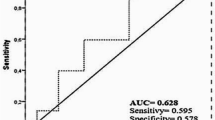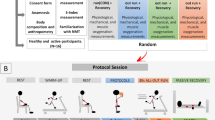Abstract
To study the relationship between the local and systemic aerobic fitness parameters, and between the muscle oxygenation and aerobic performance, 16 female finswimmers were recruited and divided into high-level (HL) group and low-level group. Cardiorespiratory function, blood lactate concentration and near infrared spectroscopy muscle oxygenation in the vastus lateralis (VL) were monitored simultaneously during a maximal incremental exercise. We found that the break point (Bp) of the oxygenation index (OI) in the VL (BpVL) had significant correlations with lactate threshold (LT) and gas exchange threshold (GET), and the appearance sequence of the three thresholds was BpVL ≈ LT ≤ GET. When considering different levels, the \( \dot{V}{\text{O}}_{2} \) at BpVL, LT and GET were higher in the HL group. During intensive exercise, there were significantly faster \( \dot{V}{\text{O}}_{2} \) increase and evidently slower OI decrease in the HL group, suggesting that faster \( \dot{V}{\text{O}}_{2} \) increase in the HL group slowed down the muscle deoxygenation and facilitated subjects to cycle to higher workloads. In conclusion, multi-modality approaches combining local and systemic physiological monitoring technologies might provide better explanations of the relationship between local and systemic aerobic fitness parameters, and might be a novel way to analyze the difference between groups of different levels.




Similar content being viewed by others
References
Adam G, Kalaitzoglidis Y, Tsalis G (2005) Developments in Finswimming. Inq Sport Phys Educ 3(1):48–54
Amann M, Subudhi AW, Walker J, Eisenman P, Shultz B, Foster C (2004) An evaluation of the predictive validity and reliability of ventilatory threshold. Med Sci Sports Exerc 36(10):1716–1722
Baquet G, van Praagh E, Berthoin S (2003) Endurance training and aerobic fitness in young people. Sports Med 33(15):1127–1143
Barstow TJ, Jones AM, Nguyen PH, Casaburi R (2000) Influence of muscle fibre type and fitness on the oxygen uptake/power output slope during incremental exercise in humans. Exp Physiol 85(1):109–116
Beaver WL, Wasserman K, Whipp BJ (1985) Improved detection of lactate threshold during exercise using a log–log transformation. J Appl Physiol 59(6):1936–1940
Belardinelli R, Barstow TJ, Porszasz J, Wasserman K (1995) Changes in skeletal muscle oxygenation during incremental exercise measured with near infrared spectroscopy. Eur J Appl Physiol 70(6):487–492
Bentley DJ, Newell J, Bishop D (2007) Incremental exercise test design and analysis—implications for performance diagnostics in endurance athletes. Sports Med 37(7):575–586
Bhambhani YN (2004) Muscle oxygenation trends during dynamic exercise measured by near infrared spectroscopy. Can J Appl Physiol 29(4):504–523
Bhambhani YN, Buckley SM, Susaki T (1997) Detection of ventilatory threshold using near infrared spectroscopy in men and women. Med Sci Sports Exerc 29(3):402–409
Bhambhani Y, Buckley S, Susaki T (1999) Muscle oxygenation trends during constant work rate cycle exercise in men and women. Med Sci Sports Exerc 31(1):90–98
Bhambhani Y, Maikala R, Esmail S (2001) Oxygenation trends in vastus lateralis muscle during incremental and intense anaerobic cycle exercise in young men and women. Eur J Appl Physiol 84(6):547–556
Bhambhani YN, Kennedy MD, Maikala RV (2010) Cardiorespiratory and vastus lateralis oxygenation-blood volume responses during incremental and modified Wingate tests. Int J Ind Ergon 40(2):197–205. doi:10.1016/j.ergon.2009.10.004
Boone J, Koppo K, Barstow TJ, Bouckaert J (2009) Pattern of deoxy[Hb+Mb] during ramp cycle exercise: influence of aerobic fitness status. Eur J Appl Physiol 105(6):851–859. doi:10.1007/s00421-008-0969-2
Boone J, Koppo K, Barstow TJ, Bouckaert J (2010) Aerobic fitness, muscle efficiency, and motor unit recruitment during ramp exercise. Med Sci Sports Exerc 42(2):402–408. doi:10.1249/MSS.0b013e3181b0f2e2
Boushel R, Langberg H, Olesen J, Gonzales-Alonzo J, Bulow J, Kjaer M (2001) Monitoring tissue oxygen availability with near infrared spectroscopy (NIRS) in health and disease. Scand J Med Sci Sports 11(4):213–222
Brooks GA (2000) Intra- and extra-cellular lactate shuttles. Med Sci Sports Exerc 32(4):790–799
Cohen J (1992) A power primer. Psychol Bull 112(1):155–159
Davis JA, Rozenek R, DeCicco DM, Carizzi MT, Pham PH (2007) Comparison of three methods for detection of the lactate threshold. Clin Physiol Funct Imaging 27(6):381–384
Demello JJ, Cureton KJ, Boineau RE, Singh MM (1987) Ratings of perceived exertion at the lactate threshold in trained and untrained men and women. Med Sci Sports Exerc 19(4):354–362
Dickhuth HH, Yin L, Niess A, Rocker K, Mayer F, Heitkamp HC, Horstmann T (1999) Ventilatory, lactate-derived and catecholamine thresholds during incremental treadmill running: relationship and reproducibility. Int J Sports Med 20(2):122–127
Faul F, Erdfelder E, Lang A-G, Buchner A (2007) G*Power 3: a flexible statistical power analysis program for the social, behavioral, and biomedical sciences. Behav Res Methods 39(2):175–191
Ferrari M, Mottola L, Quaresima V (2004) Principles, techniques, and limitations of near infrared spectroscopy. Can J Appl Physiol 29(4):463–487
Gaskill SE, Ruby BC, Walker AJ, Sanchez OA, Serfass RC, Leon AS (2001) Validity and reliability of combining three methods to determine ventilatory threshold. Med Sci Sports Exerc 33(11):1841–1848
Gautier J, Baly L, Zanone PG, Watier B (2004) A kinematic study of finswimming at surface. J Sports Sci Med 3(2):91–95
Gladden LB (2000) Muscle as a consumer of lactate. Med Sci Sports Exerc 32(4):764–771
Grassi B, Quaresima V, Marconi C, Ferrari M, Cerretelli P (1999) Blood lactate accumulation and muscle deoxygenation during incremental exercise. J Appl Physiol 87(1):348–355
Hamaoka T, McCully KK, Quaresima V, Yamamoto K, Chance B (2007) Near-infrared spectroscopy/imaging for monitoring muscle oxygenation and oxidative metabolism in healthy and diseased humans. J Biomed Opt 12(6):062105
Hug F, Decherchi P, Marqueste T, Jammes Y (2004) EMG versus oxygen uptake during cycling exercise in trained and untrained subjects. J Electromyogr Kinesiol 14(2):187–195
Jones AM, Carter H (2000) The effect of endurance training on parameters of aerobic fitness. Sports Med 29(6):373–386
Jones AM, Carter H (2004) Oxygen uptake-work rate relationship during two consecutive ramp exercise tests. Int J Sports Med 25(6):415–420. doi:10.1055/s-2004-820960
Jones AM, Campbell IT, Pringle JSM (2004) Influence of muscle fibre type and pedal rate on the VO2-work rate slope during ramp exercise. Eur J Appl Physiol 91(2–3):238–245
Legrand R, Marles A, Prieur F, Lazzari S, Blondel N, Mucci P (2007) Related trends in locomotor and respiratory muscle oxygenation during exercise. Med Sci Sports Exerc 39(1):91–100
Lin YQ, Lech G, Nioka S, Intes X, Chance B (2002) Noninvasive, low-noise, fast imaging of blood volume and deoxygenation changes in muscles using light-emitting diode continuous-wave imager. Rev Sci Instrum 73(8):3065–3074. doi:10.1063/1.1485779
Mc Naughton LR, Thompson D, Philips G, Backx K, Crickmore L (2002) A comparison of the lactate Pro, Accusport, Analox GM7 and Kodak Ektachem lactate analysers in normal, hot and humid conditions. Int J Sports Med 23(2):130–135. doi:10.1055/s-2002-20133
Mogensen M, Bagger M, Pedersen PK, Fernstrom M, Sahlin K (2006) Cycling efficiency in humans is related to low UCP3 content and to type I fibres but not to mitochondrial efficiency. J Physiol 571(Pt 3):669–681
Pyne DB, Boston T, Martin DT, Logan A (2000) Evaluation of the Lactate Pro blood lactate analyser. Eur J Appl Physiol 82(1–2):112–116
Sako T, Hamaoka T, Higuchi H, Kurosawa Y, Katsumura T (2001) Validity of NIR spectroscopy for quantitatively measuring muscle oxidative metabolic rate in exercise. J Appl Physiol 90(1):338–344
Santos EL, Giannella-Neto A (2004) Comparison of computerized methods for detecting the ventilatory thresholds. Eur J Appl Physiol 93(3):315–324. doi:10.1007/s00421-004-1166-6
Scheuermann BW, Tripse McConnell JH, Barstow TJ (2002) EMG and oxygen uptake responses during slow and fast ramp exercise in humans. Exp Physiol 87(1):91–100
Simon J, Young JL, Blood DK, Segal KR, Case RB, Gutin B (1986) Plasma lactate and ventilation thresholds in trained and untrained cyclists. J Appl Physiol 60(3):777–781
Sorensen VB, Wroblewski H, Galatius S, Haunso S, Kastrup J (2000) Assessment of continuous skeletal muscle blood flow during exercise in humans. Microvasc Res 59(2):301–309
Stringer W, Wasserman K, Casaburi R, Porszasz J, Maehara K, French W (1994) Lactic acidosis as a facilitator of oxyhemoglobin dissociation during exercise. J Appl Physiol 76(4):1462–1467
Stringer WW, Hansen JE, Wasserman K (1997) Cardiac output estimated noninvasively from oxygen uptake during exercise. J Appl Physiol 82(3):908–912
Stringer WW, Whipp BJ, Wasserman K, Porszasz J, Christenson P, French WJ (2005) Non-linear cardiac output dynamics during ramp-incremental cycle ergometry. Eur J Appl Physiol 93(5–6):634–639
Sullivan MJ, Knight JD, Higginbotham MB, Cobb FR (1989) Relation between central and peripheral hemodynamics during exercise in patients with chronic heart failure. Muscle blood flow is reduced with maintenance of arterial perfusion pressure. Circulation 80(4):769–781
Thin AG, Linnane SJ, McKone EF, Freaney R, FitzGerald MX, Gallagher CG, McLoughlin P (2002) Use of the gas exchange threshold to noninvasively determine the lactate threshold in patients with cystic fibrosis. Chest 121(6):1761–1770
Vella CA, Robergs RA (2005) Non-linear relationships between central cardiovascular variables and VO2 during incremental cycling exercise in endurance-trained individuals. J Sports Med Phys Fitness 45(4):452–459
Wang LX, Yoshikawa T, Hara T, Nakao H, Suzuki T, Fujimoto S (2006) Which common NIRS variable reflects muscle estimated lactate threshold most closely? Appl Physiol Nutr Metab 31(5):612–620. doi:10.1139/h06-069
Wang B, Tian Q, Zhang Z, Gong H (2009) Comparison between the changes in muscle oxygenation and blood lactate concentration in finswimmers during incremental exercise. In: Eighth international conference on photonics and imaging in biology and medicine (PIBM 2009), Wuhan, China. SPIE, USA, pp 75190C–75198
Wasserman K (1987) Determinants and detection of anaerobic threshold and consequences of exercise above it. Circulation 76 (6 Pt 2):VI29–39
Wasserman K, Whipp BJ, Koyl SN, Beaver WL (1973) Anaerobic threshold and respiratory gas exchange during exercise. J Appl Physiol 35(2):236–243
Wasserman K, Hansen J, Sue D (1991) Facilitation of oxygen consumption by lactic acidosis during exercise. News Physiol Sci 6(1):29–34
Wolf M, Ferrari M, Quaresima V (2007) Progress of near-infrared spectroscopy and topography for brain and muscle clinical applications. J Biomed Opt 12(6):062104
Yoshida T, Takeuchi N, Suda Y (1982) Arterial versus venous blood lactate increase in the forearm during incremental bicycle exercise. Eur J Appl Physiol Occup Physiol 50(1):87–93
Zhang Z, Wang B, Nie Q, Luo Q, Gong H (2009) Portable muscle oxygenation monitor based on near infrared spectroscopy. Front Optoelectron China 2(3):248–252. doi:10.1007/s12200-009-0050-8
Zhang Z, Wang B, Gong H, Xu G, Nioka S, Chance B (2010) Comparisons of muscle oxygenation changes between arm and leg muscles during incremental rowing exercise with near-infrared spectroscopy. J Biomed Opt 15(1):017007
Zhou B, Conlee RK, Jensen R, Fellingham GW, George JD, Fisher AG (2001) Stroke volume does not plateau during graded exercise in elite male distance runners. Med Sci Sports Exerc 33(11):1849–1854
Acknowledgments
We wish to thank all the subjects for their enthusiastic participation. Also, we would like to acknowledge Guodong Xu, Kunru Lv, Yanjie Ye, Li Qin and Peicai Wang from Wuhan Institute of Physical Education (Wuhan, China) for their helpful assistance. This work was mainly supported by the Program for Changjiang Scholars and Innovative Research Team in University, the 111 projects (B07038), and the National Nature Science Foundation of China (30770554).
Conflict of interest
The authors declare that they have no conflict of interest.
Author information
Authors and Affiliations
Corresponding author
Additional information
Communicated by Susan A. Ward.
Rights and permissions
About this article
Cite this article
Wang, B., Tian, Q., Zhang, Z. et al. Comparisons of local and systemic aerobic fitness parameters between finswimmers with different athlete grade levels. Eur J Appl Physiol 112, 567–578 (2012). https://doi.org/10.1007/s00421-011-2007-z
Received:
Accepted:
Published:
Issue Date:
DOI: https://doi.org/10.1007/s00421-011-2007-z




